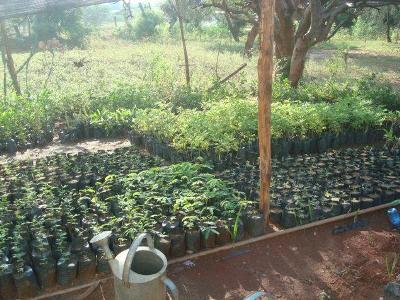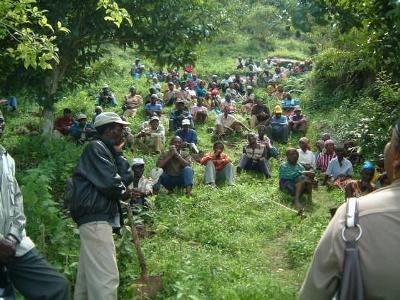John Mlamba
The main of my project is the conservation of the critically endangered Sagalla caecilian Bulengerula niedeni through the restoration of indigenous forest cover in Sagalla and the rehabilitation of the wet areas through a livelihood generation activity.

Tree seedlings in the nursery.
The project arises out the research carried out in Sagalla on the endemic and critically endangered Sagalla caecilian and from the recommendations of the Lower Voi river/Sagalla sub-catchment management plan. The proposed activities are geared towards restoration of the indigenous forest cover and to stop further degradation of the habitat areas of the caecilian that include riverine areas. The activities include awareness creation, establishment of tree nurseries and planting of indigenous trees, training of farmers on fish farming and initiation of fish farming as a livelihood generation and conservation activity.

A public meeting and a tree planting day.
The current scenario was created by past activities carried out by both the government and the local community. The indigenous forest (about 203ha) was replaced (around 1955) with eucalyptus in order to create plantations for the supply of fuel wood for the steam engines and planting on farms (around 1980s) for the provision of domestic energy needs and for timber. This has resulted in reduced catchment function of the forest area and the drying up of streams and springs thus threatening the continued existence of the caecilian. In the quest for livelihood generation the local community (steeped in poverty) have encroached on the riverine and wet areas draining them and cultivating crops further reducing the water storage areas. The dry seasons are marked with severe drought where water availability even for domestic use becomes a problem – the watering-holes are becoming deeper each year indicating falling groundwater levels.
In the long-run, the project aims at the gradual replacement of eucalyptus trees with indigenous trees both in the forest and on farms and the rehabilitation of the wet and riverine areas crucial for water catchment. Farmers would be encouraged to apply environmentally friendly farming techniques suitable for the wet areas such as fish farming and to apply soil and water conservation methods (such as terracing and use of vertiver grass to control soil erosion).